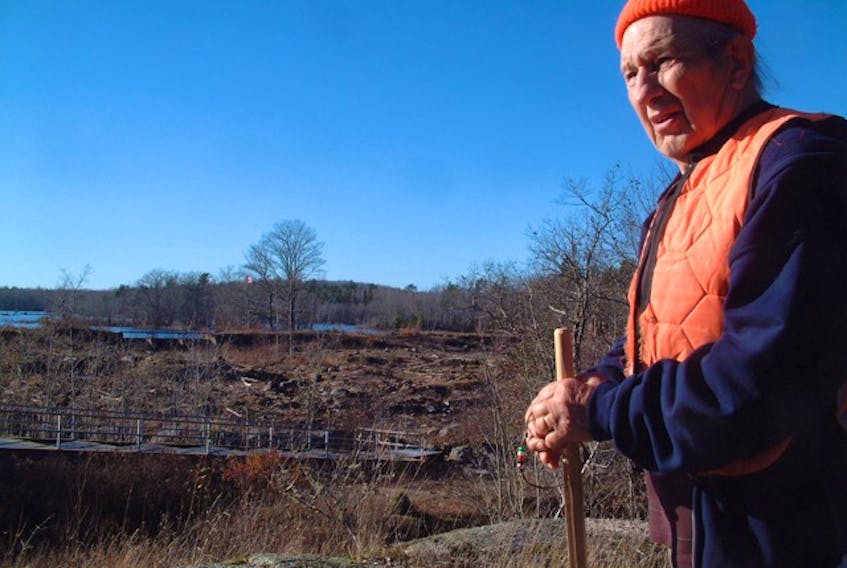SOUTH ALTON, N.S. — Everybody makes the statement now, but I’m convinced the words are often hollow.
‘We are located in Mi’kma’ki, the ancestral and unceded territory of the Mi’kmaq. We are all Treaty people.’
If those words were more than tokenism Henry Dorey would be able to see two signs at Gaspereau Lake now — one acknowledging his ancestors and another protecting their sacred burial ground by the water.
I first met Henry when he was 75. After years of talking to politicians at various levels and leading one-on-one tours to the lakefront, he just turned up at The Advertiser office one day offering to show me what he believes in so passionately.
I got in his truck and we drove out the New Ross Road. As you get near the lake there’s a homemade sign that says, ‘Dorey’s Landing.’ It’s a beautiful, shallow lake — undeveloped, except for a power dam.
The Truth and Reconciliation Commission’s report came out in 2015. The words ‘truth and reconciliation’ continue to be bandied about, too. I still have the 2017 photo I took outside the Just Us Coffee Roastery, which contrasted ‘Canada 150, Mikimaki 13,000’.
Henry is 84 years old now. He is still a patient man, but he feels his age more. The provincial government has obviously ignored his request. Nova Scotia Power also offers a wall of corporate bureaucracy.
Back in 2013, I was told by then culture minister Leonard Preya’s staff that final decisions on land use and potential additions to the dam were slated for March 31. Preyra paid lip service to the notion that protecting Mi’kmaq heritage resources is important to all Nova Scotians. To date nothing has resulted to satisfy history.
Henry, who is an off-reserve Native, grew up beside the lake, so he heard the unwritten history of the land. His family’s farm was absorbed by the construction of Highway 12.
Ellen Hunt of the Mi'kmaq Burial Grounds Research and Restoration Association said the burial ground should be a recognized site. She burned sweet grass in a spring equinox ceremony by the lake one March day.
"I mean, you have Louisburg, a French site that's protected,” she told me. “We have lived on this land many, many years before the French came here. Why can't we have our heritage and our burial sites protected as well?"
The Assembly of Nova Scotia Mi’kmaq Chiefs had some direct involvement, including the archaeological research that yielded a large number of artifacts. But nobody in authority wanted to talk about what was found.
Elder Gerald Toney of the Annapolis Valley First Nation did note potential flooding to increase the dam level would destroy artifacts that haven’t been removed yet.
"If we as Mi'kmaq people got together and went digging up a graveyard or a heritage site of the French, the English or any other nationality, the feelings they would get from that is the same way we feel about it," he said.
It is commonly accepted that for centuries the lake was a winter dwelling place for the nomadic Mi’kmaw. Jim Legge, of Greenwich, assembled 12 flawless spear points that he found on the shores of the lake. Spear points, but not foundations, were left behind.
The power dam wasn’t established until 1929, which makes it pretty recent history. The oldest archeological site in eastern North America, for example, was discovered shortly after the Second World War, at Debert. It stretches back 10 centuries.
Why are Nova Scotia school children made to mark Mi’kmaq history month when so little genuine reconciliation is being done? Henry has said, “we’re standing still.” As long ago as the 1970s, the Supreme Court recognized that Aboriginal title to land was based on "historic occupation and possession" of traditional territories.
Last week I got to hear Mi’kmaq theologian Dr. Terry LeBlanc speak about who owns this land. He stated that his people still live under a colonial form of government, whereby “the Indian Act treats us as wards.”
I have to agree with this Acadia University honorary degree recipient. He firmly believes there is a better way for us white folks to behave. One sign of truly good intent would be to grant Henry Dorey the visible acknowledgement he has sought for so long.
Former Advertiser and Register reporter Wendy Elliott lives in Wolfville.









